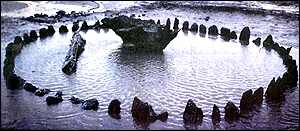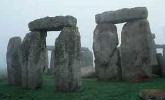
|
|
|
New
Nation News - European Pre-History News
|

|
|
| "For there is hope of a tree, if it be cut down, that it will sprout again," |
| Kennewick Man | Western Civilization | news links | March 6, 2013 |
|
(note: some older links may
have expired - ed.)
|
|
European Pre-history
News
|
Archaeologists
find six more bodies at Stonehenge Archaeologists
who last year unearthed the remains of a Bronze Age archer at Stonehenge
said Wednesday they have found six more bodies near the mysterious ring
of ancient monoliths. The remains of four adults and two children were
found about half a mile from that of the archer, dubbed ''The King of
Stonehenge'' by Britain's tabloid press. Archaeologists said he came from
Switzerland and may have been involved in building the monument. Archaeologists
who last year unearthed the remains of a Bronze Age archer at Stonehenge
said Wednesday they have found six more bodies near the mysterious ring
of ancient monoliths. The remains of four adults and two children were
found about half a mile from that of the archer, dubbed ''The King of
Stonehenge'' by Britain's tabloid press. Archaeologists said he came from
Switzerland and may have been involved in building the monument.
|
| Dozens
of women want Bronze Age hunter's babies Dozens of women have asked to be made pregnant by a prehistoric iceman who died 5,000 years ago. The body of "Otzi the Iceman" was discovered by hikers in 1991 as ice melted in the Schnalstal glacier, high in the Italian Alps. Alex Susanna, director of the Bozen Museum where his body is exhibited, says requests have been received by many women wanting to have Otzi's babies. |
Blow
to Neanderthal breeding theory Early
modern humans and Neanderthals probably did not interbreed, according
to evidence collected by Italian scientists. Researchers have long considered
Neanderthals and the humans that lived in Europe 30,000 years ago as distinct
species, even though they lived side by side. However, there is controversy
over theories that Neanderthals made a contribution to the gene pool of
people living today. This has been fuelled by a skeleton uncovered in
Portugal that appears to show both Neanderthal and human features... Early
modern humans and Neanderthals probably did not interbreed, according
to evidence collected by Italian scientists. Researchers have long considered
Neanderthals and the humans that lived in Europe 30,000 years ago as distinct
species, even though they lived side by side. However, there is controversy
over theories that Neanderthals made a contribution to the gene pool of
people living today. This has been fuelled by a skeleton uncovered in
Portugal that appears to show both Neanderthal and human features... |
|
Stonehenge
'King' Came from Central Europe  The
construction of one of Britain's most famous ancient landmarks, the towering
megaliths at Stonehenge in southern England, might have been supervised
by the Swiss, or maybe even the Germans. Archaeologists studying the remains
of a wealthy archer found in a 4,000-year-old grave exhumed near Stonehenge
last year said Monday he was originally from the Alps region, probably
modern-day Switzerland, Austria or Germany. The
construction of one of Britain's most famous ancient landmarks, the towering
megaliths at Stonehenge in southern England, might have been supervised
by the Swiss, or maybe even the Germans. Archaeologists studying the remains
of a wealthy archer found in a 4,000-year-old grave exhumed near Stonehenge
last year said Monday he was originally from the Alps region, probably
modern-day Switzerland, Austria or Germany."He would have been a very important person in the Stonehenge area and it is fascinating to think that someone from abroad -- probably modern-day Switzerland -- could have played an important part in the construction of the site," said archaeologist Andrew Fitzpatrick in a statement. The so-called "Amesbury Archer" was found in a grave about three miles from the landmark, buried with 100 items, including gold earrings, copper knives and pottery. Researchers hailed the find -- dating from about 2,300 B.C. and the oldest known grave in Britain -- as one of the richest early Bronze Age sites in Europe. He was dubbed "The King of Stonehenge" because of the lavish items found in his grave, including some of the earliest gold objects ever found in Britain. |
| Prehistoric
Britons' taste for milk The oldest direct evidence for the existence of dairy farming has been discovered in the UK. It is based on a chemical analysis of milk fat deposits left on pottery fragments found to be 6,500 years old. |
The Boudiccan rebellion and Boudicca - High Queen of the Iceni "She
was huge of frame, terrifying of aspect, and with a harsh voice. A great
mass of bright red hair fell to her knees: she wore a twisted torc, and
a tunic of many colours, over which was a thick mantle, fastened by a
brooch. Now she grasped a spear, to strike fear into all who watched her."
- Dio Cassius "She
was huge of frame, terrifying of aspect, and with a harsh voice. A great
mass of bright red hair fell to her knees: she wore a twisted torc, and
a tunic of many colours, over which was a thick mantle, fastened by a
brooch. Now she grasped a spear, to strike fear into all who watched her."
- Dio Cassius |
| Scotland:
Borders bridge may span gap in history THE hunt is on to find traces of a bridge across the Tweed believed to have been commissioned by an Anglo-Saxon king 500 years before the first recorded Borders river crossings were built in the 12th century. A Viking sword was found on the site. |
| Ireland:
Huge temple found under Hill of Tara A HUGE temple, once surrounded by about 300 huge posts made from an entire oak forest, has been discovered directly beneath the Hill of Tara in Co Meath. Conor Newman, an archaeology lecturer at NUI Galway, said the discovery at the ancient site made sense of the positioning of other graves and monuments in the area. - (forum) |
| Stonehenge
tunnel approved Mr Darling said: "The World Heritage site at Stonehenge will be enhanced and protected by putting the existing road in a bored tunnel, which will improve safety and congestion." - (forum) |
| Enthusiasts
uncover Bronze Age treasure in Wales Two enthusiasts with metal detectors have literally struck gold and their 3,000-year-old find has been formally named as treasure at an inquest in north Wales. Pete Williams and Mike Sheen, both from Wrexham, came across a hoard of bronze and gold dating back to between 1,000 and 800 BC - and are now entitled to a share of its value. - (forum) |
|
Does
skull prove that the first Americans came from Europe? -
(forum)
Alternatively, and more controversially, a group of Stone Age people from Europe made the perilous sea journey across the Atlantic Ocean many thousands of years before Columbus or the Vikings. |
| UK:
Fisherman finds Anglo-Saxon canoe off Suffolk coast A dugout canoe that was nearly chopped into firewood has turned out to be the oldest boat found off the British coast. The 16ft vessel, carved from the trunk of an oak or elm tree, was used about 1,200 years ago by the Anglo-Saxons, possibly as a ferry close to the Suffolk coast where it was found. Archaeologists believe the boat, which was discovered when it was dredged from a depth of 40ft by a trawler close to Southwold, is the only example of its kind dating back to the Anglo-Saxon era. The vessel, which was probably fitted with stabilising outriggers, has spent the past four years submerged in a muddy lagoon at Covehithe, near Southwold, while conservationists worked on it. |
The
Kensington Runestone was snubbed again. Tthe Science Museum of Minnesota will be hosting a traveling Vikings exhibit
with artifacts from the Smithsonian Institute. A replica of the Kensington
Runestone will be included in the exhibit — in the "myths
and distortions" display.
Tthe Science Museum of Minnesota will be hosting a traveling Vikings exhibit
with artifacts from the Smithsonian Institute. A replica of the Kensington
Runestone will be included in the exhibit — in the "myths
and distortions" display.LuAnn Patton, director of the Runestone Museum, was disheartened to hear about where the stone would be placed. The geological testing, although just beginning, has already shown Olof Ohman could not have been a forger, she stated. Ref: The Kensington Runestone homepage - Another website |
| "Ancient
iceman probably killed by his own people" A man frozen in Alpine ice more than 5,000 years ago could have been shot with an arrow by one of his own people. The body of "Otzi the Iceman" was discovered by hikers as ice melted in the Schnalstal glacier, high in the Italian Alps. ...the guilty party lived south of the Alps and was probably one of Otzi's own people." |
| Britain's
earliest leprosy victim may have been found A child who died 3,500 years ago may be Britain's earliest known victim of leprosy. "Most experts agree that the westward spread of the disease came from the Mediterranean where it is believed to have been introduced by the army of Alexander the Great on returning from India. |
|
|
| Face
of original Londoner revealed The face of a pre-historic British woman can be seen for the first time in over 5,000 years. The skeleton dates from the Stone Age - between 3,640 and 3,100BC. Shepperton Woman, named after the place in the west London suburbs where her grave was found, had her face rebuilt by medical artists. |
| Norway:
Archaeologists comb Stiklestad One of Norway's most fabled historical spots - Stiklestad, where Olav the Holy fell in battle in 1030 - will be the site of an autumn dig by eager archaeologists. Mass warrior graves are one possible find. |
| A
UCLA team has apparently found the Iceland home of Snorri Thorfinnsson
the first person of European descent born in the New World. Icelandic sagas from the 13th century tell the story of how Snorri's parents led the first Scandinavian group that attempted to settle in Vinland--on the Canadian coast--about AD 1000. - (VNN link) |
|
[Reader suggests]
"Inform yourself about mDNA research, read "The
Seven Daughters of Eve." On page 320 of it, there is this: "Today about 1 per cent of native Americans are the direct descendants of Xenia." If an mtDNA sample can be secured from Kennewick Man, Xenia just might have been his Clan Mother. "The book's most complex and controversial find that the ancient European hunter-gatherers predominated over the farmers and not vice versa leads Sykes to another stunning conclusion: by chance, nearly all modern Europeans are descendants of one of seven "clan mothers" who lived at different times during the Ice Age." |
|
Iceman's
final meal The last two meals eaten by the 5,300-year-old iceman, dubbed Oetzi, have been revealed by scientists. Analysis of the contents of the Stone Age human's intestines shows he probably dined on venison just before his death, having previously consumed cereals, plants, and ibex meat. |
| Did
The Welsh Discover America? A team of historians and researchers announced today that Radio Carbon dating evidence, and the discovery of ancient British style artefacts and innoscriptions in the American Midwest, provide the strongest indications yet" that British explorers, under the Prince Madoc ap Meurig, arrived in the country during the 6th Century and set up colonies there. |
|
  The
Celt Site The
Celt Site(click on Rooster Mascot at left for very slow load to Entrance of site or click on CeltSite Logo at right to go directly to the main menu) |
|
Neanderthal Britons ate mammoth steak, a remarkable archaeological discovery has shown. Excavations at a gravel pit near Lynford in Norfolk found evidence suggesting that, 50,000 years ago, mammoth meat was a substantial part of the diet of the now- extinct human species Homo neanderthal-ensis, popularly known as Neanderthal Man. |
| Faces
from the Ice Age What could be the oldest lifelike drawings of human faces have been uncovered in a cave in southern France. From the La Marche caves there are lions, bears, antelope, horses - and 155 lifelike human figures. These images of "real people" - male and female faces, people in robes, hats and boots - may date back 15,000 years. This was long before the rise of the great civilisations and a time when Europe was firmly in the grip of an Ice Age. |
|
Reader suffering
from DUPUYTREN'S CONTRACTURE takes solace in Viking ancestry |
|
Britain:
Bronze Age archer found buried in all his splendour - and gold earrings
Vikings
who found their longboat up a smelly creek have placenames restored |
| The
Working Celtic Cross By Crichton E M Miller In 1997 Crichton Miller made an astounding discovery that will change our concepts of the historical and religious past forever. Crichton's background and life experiences play a fundamentally important part in this revelation; he is a qualified yachtsman and navigator with an interest in ancient history and religions. Through the results of intensive research, Crichton proposes that our present system of beliefs and science was inherited from ancient mariners that sailed the oceans of the world in prehistory. He further proposes that the abrupt end of the last ice age, 12,500 years ago, was part of a cataclysm that destroyed of a large part of the flora and fauna of Earth. The most likely humans to survive this cataclysmic event were those who were at sea. - (reader link) |
|
|
|
|
|
|
|
|
| Anthropology
in the News - Breaking News The Ancient World - Breaking News Archaeology Magazine |
| since 8/22/98 | web site map |